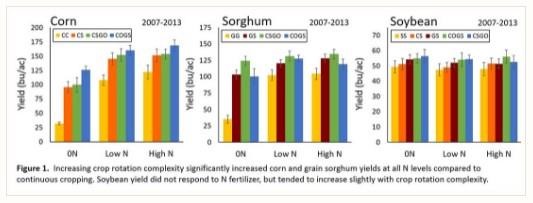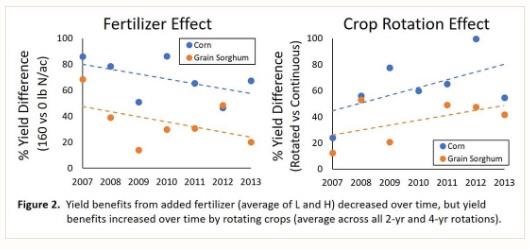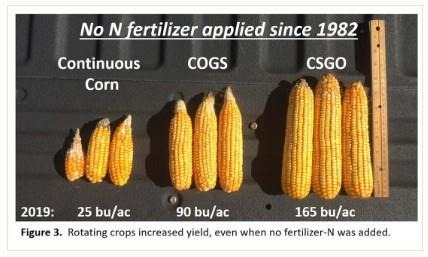By Susan E. Wagner and Virginia Jin et.al
Farm profitability from grain production is an age-old concern of farmers. Improving yield stability is also an important management strategy to counteract weather extremes (i.e., heat waves, droughts, flooding) that stress both crop growth and farm profitability. Farmers need reliable information about the effectiveness of crop rotation and fertilizer management that involves many years of data to account for the year-to-year variability in growing conditions.
Here, we share the results from a long-term rainfed no-till crop rotation and nitrogen (N) fertilizer systems study conducted by the USDA Agricultural Research Service at the University of Nebraska-Lincoln’s Eastern Nebraska Research and Extension Center (ENREC) (Table 1). While producers typically increase fertilizer amounts for continuous crops, fertilizer inputs were determined by the crop phase present during the year of application to maintain experimental uniformity.
Table 1. Site treatment descriptions and starting year.1| Treatment | Year Started | Description | Abbreviation |
|---|
| Crop rotation | 1972 | Continuous corn | CC |
|---|
| | | Continuous soybean | SS |
|---|
| | | Continuous grain sorghum | GG |
|---|
| | | Corn – soybean | CS |
|---|
| | | Grain sorghum – soybean | GS |
|---|
| | | Corn – soybean – grain sorghum – oat/clover2 | CSGO |
|---|
| | | Corn – oat/clover – grain sorghum – soybean | COGS |
|---|
| Nitrogen rate3 | 1982 | No N (0 lb N/ac) | 0N |
|---|
| | | Low N (80 lb N/ac for C, G; 30 lb N/ac for S) | Low N |
|---|
| | | High N (160 lb N/ac for C, G; 60 lb N/ac for S) | High N |
|---|
1Study converted to no-till in 2007. Crop data presented here for no-till years 2007-2013. All phases of each crop rotation were present in every year of this study. Soils data collected in 2016.
2The clover mixture was 20% red clover and 80% yellow sweet clover by weight and planted after oat harvest (16 lb/ac). The clover mix was a winter cover crop that was chemically terminated in the spring before planting the next grain crop.
3Nitrogen was manually broadcast as early-season side dress using ammonium nitrate (34-0-0) from 1982 to 2006, then as granular urea (46-0-0) from 2007 to present. Fertilizer additions to soybean were included to evaluate whether potential yield benefits might offset additional N input cost.

1. More diverse rotations improve yield and yield stability.
- Under no fertilization (0N), yield for corn or grain sorghum rotated with soybean was similar to grain yield in fertilized continuous cropping systems (Figure 1).
- Compared to continuous cropping, fertilized corn yield improved 29% and fertilized grain sorghum yield improved 20% when grown in two-year rotations, and up to 48% (corn) and 29% (grain sorghum) when grown in four-year rotations that included a legume winter cover crop in just one of four of those years (Figure 1).
- Soybean yield was stable regardless of N application and tended to improve with rotation complexity (Figure 1).
- Rotating crops increased long-term yield stability and decreased crop losses during drought by 14-90% compared to continuous cropping.

2. Yield benefits from crop rotations are similar to N fertilizer, but more stable over time.
- Yield responses for corn and grain sorghum were similar at low N (80 lb N/ac) and high N (160 lb N/ac), suggesting that crop N demands were met at the low N rate (Figure 1).
- Adding fertilizer-N to the most diverse rotations (CSGO, COGS) did not increase yield (Figure 1).
- Fertilizer-N responses decreased over time, but crop rotation benefits were maintained (grain sorghum) or increased (corn) over time (Figure 2). This suggests that the benefits of rotation on crop N nutrition increasingly displaced the effect of fertilizer N over time.
- Rotating crops increased yields similar to fertilizer-N even with no fertilizer use (0N) (Figure 3).
- The sequence of crops in rotation also affected yield outcomes (COGS vs CSGO) (Figure 3).

3. More diverse crop rotations had more soil organic C (SOC) than fertilizer-N.
- The SOC increased with rotation diversity down to 5 feet deep (Table 2).
- The grain sorghum/soybean rotation had the lowest SOC content to 5 feet depth due to lower root mass and length in both crop types.
- The effect of crop rotation effects on SOC were equal to or greater than the effect of fertilizer-N.
- Clover cover crops added N to the soil for crop and microbial uptake.
- Crop rotation and cover crops can build soil organic matter and improve soil water retention, likely contributing to more stable yields and greater resilience to adverse weather.
Table 2. Crop rotation (averaged over N rates) and fertilizer-N effects (averaged over crop rotations) on soil organic carbon and total soil N (ton/acre).
| Management | Treatment Description | Soil Organic Carbon
(ton C/acre) | | Soil Total Nitrogen
(ton N/acre |
|---|
Soil Depth (inches)
0-3" | Soil Depth (inches)
0-12" | Soil Depth (inches)
0-60" | | Soil Depth (inches)
0-3" | Soil Depth (inches)
0-12" | Soil Depth (inches)
0-60" |
|---|
| Crop rotation | Continuous corn | 7.4 | 24.0 | 48.1 | | 0.69 | 2.28 | 5.40 |
|---|
| | Continuous soybean | 7.7 | 25.2 | 57.9 | | 0.70 | 2.36 | 6.11 |
|---|
| | Continuous grain sorghum | 8.3 | 25.7 | 51.9 | | 0.78 | 2.45 | 5.58 |
|---|
| | Corn — soybean | 8.0 | 25.6 | 62.5 | | 0.74 | 2.41 | 6.47 |
|---|
| | Grain sorghum — soybean | 8.1 | 24.1 | 47.8 | | 0.76 | 2.36 | 5.44 |
|---|
| | Corn — soybean — grain sorghum — oat/clover | 9.0 | 27.9 | 65.1 | | 0.84 | 2.63 | 6.83 |
|---|
| | Corn — oat/clover — grain sorghum — soybean | 8.8 | 26.5 | 60.5 | | 0.83 | 2.54 | 6.47 |
|---|
|
| Nitrogen rate | None | 7.9 | 25.4 | 57.5 | | 0.74 | 2.41 | 6.11 |
|---|
| | Low | 7.5 | 25.5 | 55.7 | | 0.76 | 2.41 | 5.98 |
|---|
| | High | 8.3 | 25.8 | 55.7 | | 0.78 | 2.45 | 6.07 |
|---|
Conclusions
Crop rotation has been used by farmers for generations to improve grain yields by regenerating the soil and breaking the cycles of weeds, diseases and insect damage to crops. Our long-term study in eastern Nebraska showed that crop rotation had more agronomic and soil benefits compared to fertilizer-N alone. Fertilizer-N use, while beneficial, was no substitute for using crop rotation. In the long-term, rotating two or more crops can improve the soil and crop yields with less fertilizer-N cost.
Source : unl.edu